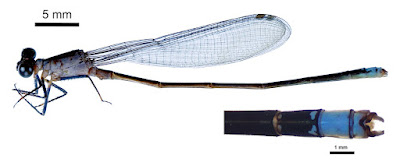 |
| Nesobasis rito Rivas-Torres & Cordero-Rivera, in Rivas-Torres, Rashni, Waqa-Sakiti, Tuiwawa & Cordero-Rivera, 2021. |
Abstract
Nesobasis rito sp. nov. (Holotype ♂, Fiji, Vanua Levu, Drawa, 31 v 2018, A. Rivas-Torres leg.) from the comosa group is here described, illustrated, diagnosed, and compared with morphologically close species of the genus. Nesobasis rito can be distinguished from its related congeners by the shape of the caudal appendages and the ligula. The most similar species are N. comosa and N. heteroneura, which, like N. rito, have the caudal appendages covered by dense setae (especially the first species), but the shape differs clearly in lateral view, with N. rito having longer and more slender appendages, and a basal tooth clearly seen in dorsal view, absent in other members of the comosa group. The specific status of the collected specimens is also supported by the results of genetic analyses, where N. rito appears as a well-supported monophyletic clade. Nesobasis rito also has a distinct distribution from its most similar congeners: it is found on Vanua Levu, while N. comosa is found on Viti Levu and the closely related N. heteroneura is found on Viti Levu and Ovalau. All species of this group are found in streams with native forest riparian vegetation on their respective islands.
Key words: Odonata, Zygoptera, Nesobasis, taxonomy, Vanua Levu, Fiji
 |
| Nesobasis rito sp. nov., holotype male; habitus and dorsal view of S7–10, showing the blue spots and the caudal appendages. |
Nesobasis rito sp. nov. Rivas-Torres & Cordero-Rivera
Differential diagnosis. According to its morphology, N. rito belongs to the comosa group as defined by Donnelly(1990), which includes N. comosa, N. heteroneura, N. aurantiaca, N. malcolmi and N. martina. Based on the phylogeny of Beatty et al. (2017) this is a highly supported clade. One unique feature of N. rito is a notch at around the middle from the posterior lobe of the prothorax that makes it somewhat bilobed (Fig. 2a). Nesobasis rito differs markedly in its appendages from N. malcolmi and N. aurantiaca, two species that have very short caudal append-ages. Nesobasis rito resembles N. comosa because the caudal appendages are covered by dense setae, although their shape differs clearly in lateral view: N. rito has longer and more slender appendages, and a basal tooth that can be seen in dorsal view (Fig. 2e) which is absent in N. comosa. The general body colouration and the cerci resemble also those of N. heteroneura, although, in N. rito, the cerci are longer, with more pilosity and differ also by the presence of the basal teeth. Furthermore, the blue spots of S8 are not mentioned in the description of N. heteroneura orN. comosa. The genital ligula in lateral view (Fig. 3a) is similar to that of N. comosa, but with the distal segment broader and the lateral lobes more pronounced (compared to Fig. 103, Donnelly, 1990). In ectal view (Fig. 3b) more elongated than the ligula of N. comosa and the lateral lobes clearly visible (compared to Fig. 104, Donnelly, 1990). Like N. heteroneura, the wings of N. rito have a single row of cells distal from the pterostigma but in N. comosawings have mostly double rows of cells (M. Marinov, personal communication).
Habitat and ecology. The species was found in shallow but wide streams (about 4–5 m wetted channel width, Fig. 5f), commonly in shaded areas, with native riparian vegetation, but in the open as well. Males perched both in the vegetation (Fig. 5b, c) and on stones in the middle of the stream (Fig. 5a). Females lay eggs alone and may go underwater to oviposit (Fig. 5d, e).
Etymology. Named rito (noun in apposition) which in Spanish means ritual, to honour the local community rituals of Drawa village, which we enjoyed before finding the specimens, but also as an acronym of Rivas-Torres, as an appreciation of the first author to her family’s continuous support.
Anais Rivas-Torres, Bindiya Rashni, Hilda Waqa-Sakiti, Marika Tuiwawa and Adolfo Cordero-Rivera. 2021. Nesobasis rito sp. nov. (Zygoptera: Coenagrionidae), A New Species of Forest Damselfly from Vanua Levu, Fiji. Zootaxa. 5082(2); 101-117. DOI: 10.11646/zootaxa.5082.2.1

